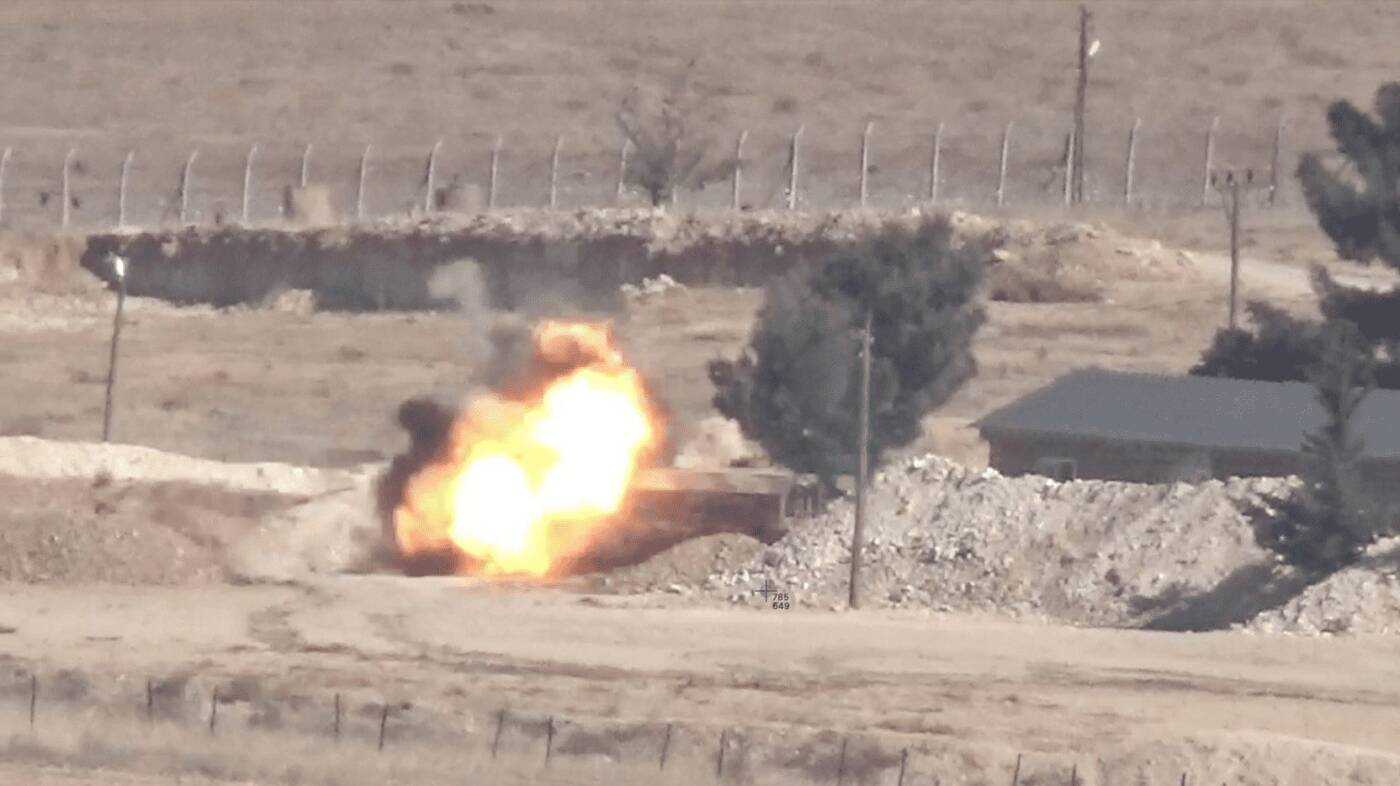Fighting between Turkish army, Kurdish-led forces in northeast Syria continues despite American efforts to de-escalate
A Turkish armored personnel carrier is struck by a missile […]
31 October 2018

AMMAN: Turkey and the Kurdish People’s Protection Units clashed near Kobane along the Syrian-Turkish border with shelling and ground clashes Tuesday night and Wednesday, after Turkish President Recep Tayyip Erdogan threatened “more extensive and effective operations” against Kurdish-led forces east of the Euphrates River.
The clashes pose a test for US diplomacy in northern Syria, pitting two regional US allies against one another. The Kurdish People’s Protection Units (YPG) operate under the umbrella of the SDF—a US-backed patchwork of armed groups formed in 2015 in order to oust the Islamic State (IS) from northeastern Syria. Meanwhile, Turkey regards both the YPG and SDF as threats located directly on its southern border with Syria.
Fighting erupted Tuesday night when Turkish artillery opened fire for the second time this week on YPG positions in Tel Abyad, reportedly killing one fighter and injuring another.
The SDF responded on Wednesday with retaliatory artillery and machine gun fire, an SDF spokesperson told Syria Direct, resulting in the destruction of one Turkish military vehicle as well as a border post near Abu Salim, a village west of Kobane.
A video released by YPG-affiliated social media pages on Wednesday appeared to show a guided anti-tank missile hitting a Turkish military vehicle.
“The fighting between our forces and the Turkish side has become very intense now,” the SDF spokesperson told Syria Direct on Wednesday.
According to Turkish state news Anadolu Agency, at least four YPG fighters were killed and another six injured during the day’s clashes.
Turkish artillery first shelled YPG positions in Tel Abyad on Sunday, but frontlines remained quiet until Tuesday night when fighting intensified.
The US has sought to de-escalate tensions between Turkey and the SDF since clashes broke out.
Russian state-affiliated news agency Sputnik quoted Pentagon spokesperson Sean Robertson as saying that the US was “in touch” with both Turkey and the SDF to “de-escalate the situation” on Tuesday.
Meanwhile, an American military committee arrived in Tel Abyad midday Wednesday to “mediate between the [Kurdish] leadership and Turkey in order to work towards de-escalation,” the SDF spokesperson told Syria Direct.
However, SDF officials and civilians told Syria Direct on Wednesday that shelling was ongoing that afternoon.
At the time of writing, the outcome of the meeting with the American delegation in Tel Abyad remains unclear. However, according to the SDF spokesperson, “there is a possibility” that a potential agreement could involve the distribution of both US and Turkish troops along the border.
Turkey’s Defence Minister recently announced that the US and Turkey were set to begin joint patrols in the northern Syrian city of Manbij this week as part of a so-called “roadmap” agreement for the city, currently held by the SDF-affiliated Manbij Military Council. Adopted in June, the agreement was designed to defuse tensions between Turkish-backed rebels and YPG fighters in the area.
Still, fears remain about the possibility of a large-scale offensive on Kurdish-held areas along the border.

In a speech to the Turkish parliament on Tuesday, President Erdogan said that the latest attacks marked the beginning of “more extensive and effective operations” against YPG positions east of the Euphrates.
Turkey has long considered the Kurdish-led YPG to be a major threat to Turkey, due to the group’s ideological ties to the Kurdistan Workers Party (PKK), a leftist Kurdish political and paramilitary group that is designated as a terrorist organization by the Turkish government. For decades, the PKK has waged a bloody insurgency in Turkey.
In 2016, Turkey launched Operation Euphrates Shield in border areas west of the Euphrates, aiming partly to drive out IS fighters and partly to prevent the YPG from advancing in those areas.
Another Turkish operation—Olive Branch—launched alongside Turkish-backed rebels earlier this year ousted the YPG from the traditionally Kurdish-majority city of Afrin as well as outlying areas of countryside. When Turkey launched Olive Branch, the US announced that it would not provide any military support to the YPG fighters in Afrin since they operated outside the realm of the US-led coalition’s mission to defeat IS.
According to some observers, there are fears within the Self-Administration—the Kurdish-led political authority that unilaterally declared its control over majority-Kurdish regions in 2013—of a repeat occurrence.
Beirut-based analyst Nour a-Din al-Omar, who recently conducted research in Kurdish-held areas of northern Syria, suggests that some Kurdish political and military officials fear that their forces could once again be left to fend for themselves.
The possibility of Turkish forces advancing into Kurdish-held areas of Syria hinges upon a US response, al-Omar said, before adding that it is “currently not in the interest of the US to abandon their strategic partners.”
“Turkey will not be able to advance east of the river without a deal with the United States,” he said. “The clashes and Turkish bombardment that are happening now are only [designed] to test the reaction of the Americans.”
Even so, recent Turkish offensives against Kurdish-majority held areas of northern Syria have left local residents fearful of what the bombing could portend.
“People are afraid,” Kobane resident Armanj Kobani said, “that the same thing that happened in Afrin may be happening here too.”







